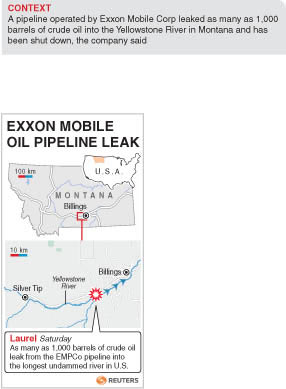Asia-Pacific
Crews mop up oil on Yellowstone River
(Agencies)
Updated: 2011-07-05 09:42
 |
Large Medium Small |
LAUREL, Montana - Exxon Mobil Corp. acknowledged under political pressure Monday that the scope of its pipeline leak into the Yellowstone River could extend far beyond a 10-mile (16-kilometer) stretch of the famed waterway.
 Map of the northern US locating an oilspill on the Yellowstone River. [Photo/Agencies] |
The company earlier had dismissed assertions from state and federal officials that the spill was spread over dozens of miles (kilometers). That drew sharp criticism from Montana Gov. Brian Schweitzer.
On Monday, Pruessing pledged that crews would begin walking the Yellowstone shoreline as soon as the flooding river recedes to look for pooled oil along the banks.
"We're not limiting the scope of our cleanup to the immediate site," Pruessing said at a news conference along the river near Laurel, as crews mopped up oil in the background. "We are not trying to suggest in any way that that's the limit of exposure."
Underscoring rising anger over the spill among some riverfront property owners, Pruessing was confronted after his news conference by a goat farmer and environmental activist who said his partner was sickened by oil fumes and had to be taken to the emergency room.
"I need to know what we've been exposed to. People are sick now," Mike Scott said. Scott's partner, Alexis Bonogofsky, was diagnosed Monday with acute hydrocarbon exposure after she experienced dizziness, nausea and trouble breathing, he said.
Pruessing said air and water monitoring had not revealed any health risks. But he told Scott the company would provide the public with more information.
Exxon Mobil has estimated that up to 1,000 barrels, or 42,000 gallons (159,000 liters), of crude oil spilled Friday night before the flow from the damaged pipeline was stopped. The break near Laurel has fouled miles of riverbank, although high water has hobbled attempts to find where all the oil went.
Montana's Disaster and Emergency Services Division was unable to give an update on the spill Monday, and Environmental Protection Agency officials also could not immediately provide any new information.
The 20-year-old Silvertip pipeline delivered 40,000 barrels a day to a refinery in Biany for its emergency response and pipeline corrosion training.
Transportation Department spokeswoman Patricia Klinger said the company has since responded to the warnings and the case was closed.
The company also was cited for "probable violations" in a February letter. Those included inadequate pipeline markers in a housing development, a section of pipeline over a ditch covered with potentially damaging material and debris, vegetation in a housing area that covered a portion of line and prevented aerial inspections, and a line over a canal not properly protected against corrosion.
The company responded in a March letter that it had corrected all of the problems, most of them within a few weeks of being notified. Company spokesman Alan Jeffers said there was no direct connection between those problems and the pipeline failure.
"These are important things we needed to take care of, and we took care of them by the time we got the notice," Jeffers said. No fines were issued, he said.
Despite Exxon Mobil's pledge to see the cleanup through to its end, the Yellowstone spill has amplified calls from some safety advocates and environmentalists who want the government to impose more stringent regulations on the industry.
The cause of the Montana spill has not yet been determined. Company and government officials have speculated that high waters in recent weeks may have scoured the river bottom and exposed the pipeline to debris that could have damaged the pipe.
The company said only one case of wildlife damage - a dead duck - had been reported, but Pruessing said that could noert Richmond said.
If another surge of water pushes oil further into back channels as expected, it could be a potential threat to fisheries, said Bruce Farling, executive director of Trout Unlimited's Montana chapter. Farling said there are many fish eggs and recently hatched fish in those channels.
The stretch of the Yellowstone where the spill occurred contains sauger, bass catfish, goldeye, trout and, farther downstream, below Miles City, native pallid sturgeon.
| 分享按钮 |